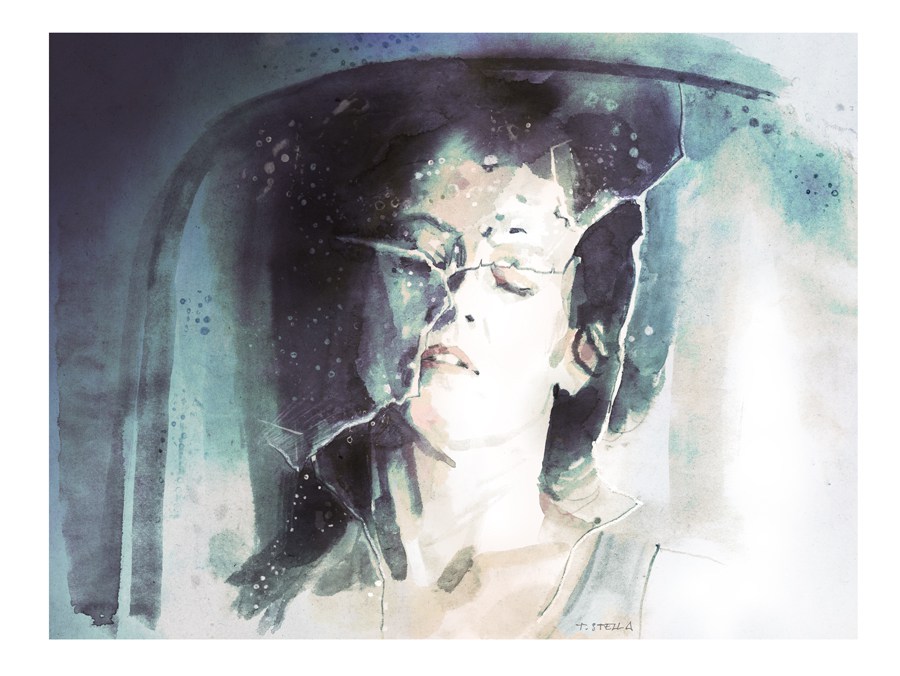We are pleased to offer an excerpt from the latest edition of the online magazine, Bright Wall/Dark Room. The theme for their August issue is BODY, and in addition to Sarah Welch’s essay below on “Alien 3,” they”ll also be featuring essays on “Body Double,” “Safe,” “The Virgin Suicides,” “Nosferatu,” “Weekend at Bernie’s II,” “George Washington,” “Pet Sematary,” “Goon,” “Alice,” “The Wizard of Oz,” and “Videodrome” throughout the month. The art above is by Tony Stella.
You can read our previous excerpts from the magazine by clicking here. To subscribe to Bright Wall/Dark Room, or look at their most recent essays, click here.
Alien 3 explores the worst form of body horror: discovering that you’ve been reduced by the people around you to the body you live in, that you will be judged for your body, and that there is no way to change this perception of you. The result cuts deeper than any ravenous monster ever could; it hurts the heart and wounds the soul.
The Alien movies perfected body horror. The alien will kill you on sight, if you’re lucky. If you’re unlucky—and you’re unlucky by default if you find yourself in an Alien film—the creature that serves as the reproductive portion of the alien’s life cycle will catch you and lay its offspring in your chest via your throat. It will nest inside your ribcage as you walk around, using you as an incubator until it’s time for the creature to be suddenly and violently born, a process that will kill you painfully. Having used your body, it will go on to inflict more pain and terror on those around you. The alien is shorthand for fear of rape.
Each of the Alien movies explore this concept in a different setting and flavor, each with their own director’s signature stamped in bold letters across its face. Alien (Ridley Scott) is cold, analytical horror, slow-moving at first until all hell breaks loose. Aliens (James Cameron) is hot-blooded action, all heart and pumping adrenaline. Alien 3 (David Fincher) rotates back to the horror of Scott’s original film, but this time it is grimy and confused, more callous and nihilistic than the original. There’s no hope to be had when you’ve crash-landed on a penal colony with an unwelcome passenger in tow.
It gets worse. The Alien universe has always been cold and unforgiving, but the maximum-security prison world of Fury 161 presents the bleakest setting yet. The atmosphere is tinted yellow; it’s easy to imagine that breathing Fury 161’s air is like breathing fumes and sweat. The planet is a leadworks, home to a skeleton crew of 25 convicts, a medic, and two wardens. Almost none of the technology works anymore. The prisoners have turned to religion, of the apocalyptic Christian fundamentalist variety. They haven’t seen a woman in years.
The subtext from the previous movies becomes text in Alien 3. The film telegraphs its intent from the very beginning, cutting rapidly back and forth between the opening credits and the demise of the survivors of the Sulaco, flying home from their mission in Aliens. A fire breaks in the cryogenic compartment where Ripley (Sigourney Weaver), Newt (Danielle Edmond), Hicks (Michael Biehn), and the android Bishop (Lance Henricksen) sleep; alarms wail as the jointed legs of a facehugger unfold. An escape pod is jettisoned, tumbling toward the dark, rocky planet Fury 161. Hicks and Newt are killed on impact. Bishop is scattered into pieces, too damaged to be considered salvageable. Ripley is doomed from the beginning. She’s a dead woman walking among convicted murderers and rapists.
The prisoners have taken vows of celibacy as part of their religion, although some are more devout than others. Their leader, Dillon (Charles S. Dutton), is upset about Ripley’s arrival, since she’s the first real “temptation”—his words—he’s encountered in years. He wants nothing to do with her. He’d elected to stay on Fury 161 after the prison was to be closed, because he wants to live out his sentence in penitence and prayer among the soaring columns of the mostly defunct machinery and the cells of his fellow prisoners. It’s a twisted interpretation of the call to be a monk, in a twisted analogue of a monastery. Dillon’s prayers emphasize his bleak worldview. In his religion, there is no grace to be had, only punishment for past crimes. To his mind, Ripley’s appearance is an unjust temptation, when he’s already done so much penitent work. His reaction to her is a mix of fear and hostility.
The prison superintendent, Andrews (Brian Glover), has an even stronger reaction. Dillon speaks to Ripley as if she’s a threat, but at least he treats her as an equal. Andrews has a tenuous hold on the top of the power structure on Fury 161, and Ripley’s arrival has cracked everything. Andrews speaks with the authority of a man who has to defend his position, and not one who has earned it. His distaste for Ripley bubbles over into outright condescension every time they talk. He calls her a “good girl” when she agrees to his demand that she stay in the sickbay away from the prisoners. The request is under the pretense of Ripley’s “personal safety”—a valid concern—but the superintendent also makes it clear that he doesn’t want “ripples in the water, and… a woman walking about giving them [the convicts] ideas.”
Ripley acknowledges Andrews’ orders to his face, but doesn’t while away her time in sickbay. She explores her environment behind Andrews’ back, digging through the trash heap for Bishop’s pieces and eating meals in the cafeteria with the prisoners. She, like the audience, knows that everyone else on the planet considers her to be the dangerous one. When Ripley and Andrews do interact, their scenes echo the interrogations from The Passion of Joan of Arc; Ripley with her head shaved, Andrews shot from a low angle. The religious imagery that pervades the film is especially obvious here: Andrews’ office looks like a cleric’s room, with oblong windows barred like stained glass framing his head.
Andrews does not want to hear anything from Ripley; nothing she can say or do is of service to him, ostensibly because she’s a woman who shouldn’t be where she is. He just wants her off the planet. At first, this suits Ripley just fine. The less she has to talk about the horrors she’s survived up to this point, the better. But even after it’s clear that there’s an alien stalking the prison, and after convicts turn up mauled in the basement passageways, Andrews still refuses to listen. “She doesn’t have all the facts,” he snaps; it never occurs to him that the danger comes not from the woman who crash-landed here, nor from the men inside his walls, but from something far worse.
The men consider her dangerous because she’s a woman, and therefore a temptation: a poor judgment on the prisoners’ worldview, because they blame her for the sudden tension in their lives. They’re unable or unwilling to question their own homicidal impulses toward her. Andrews is worse. To him, Ripley is a threat because she’s assertive, taking action without stopping to ask permission or to consult with him. She tells him to cremate the bodies from her crash landing, not to keep them on ice; she convinces Clemens to perform the autopsy without obtaining Andrews’ approval. Andrews sees her actions as a challenge to his authority. Because he has no weapons, his only power over the prisoners he oversees is information: he holds “rumor control” meetings, and is the only person who can access the outside world by sending messages to the company. As someone else from the outside, Ripley threatens to topple his hold on power because she has her own information.
Whether Andrews is conscious of this or not is left ambiguous, but his reaction is anything but. His only defense is outright sexism: sequestering Ripley away from the others, belittling her as a “good girl” and claiming that she “doesn’t have all the facts,” and therefore cannot contribute anything to their little microcosm of society—ironic cruelty, as his second in command, nicknamed “85” for his IQ, does nothing of import but parrot Andrews’ orders. Ripley is made a second class citizen on a prison world. She is just as intelligent and capable as the men around her. She even looks like them: her head is shaved to prevent the spread of lice, and the baggy, shapeless clothes she wears obscure her body. But still, she’s an outcast among outcasts, feared and hated only because of her gender.
The only sympathetic person on Fury 161 is Clemens (Charles Dance), the medic. He’s initially skeptical of Ripley’s story—the crash is suspicious, and she’s sparing with the facts of her life, at least at first—but he comes around quickly when she asks to see Newt’s body.
The autopsy stands out as one of the best scenes in the film. It’s cold and unpleasant, but spare, stripped down to shots of the child’s frozen eyelashes, a morgue slab, a bone saw in the hands of a sympathetic but skeptical doctor. There’s a splash of blood, then a cracked chest, and nothing more. Ripley confirms for herself that Newt did not die as host to an alien. She’s desperate for closure, but unwilling to answer Clemens’ questions herself; others have disbelieved her before when she’s told them about the alien. The only people who have believed her story have underestimated the dangers that the alien presents, or have tried to use her as an expendable asset to acquire the alien for their own purposes. It never ends well. She’s left a trail of death in her wake, followed across space by a ravenous monster. The alien has insinuated itself into her life so fully that she “can’t remember anything else.” In the face of this new, raw, young death, Ripley doesn’t care to make herself any more vulnerable than she already is.
And she is vulnerable, perhaps more than she’s ever been. She’s been questioned before, but that was by the corporate wing of the company, eager to close the book on a failed mission and happy to have a scapegoat for a destroyed refinery. She’s been scoffed at, but that was by the contingent of marines sent to investigate the sudden radio silence of a human colony, convinced that there’s no danger to them and their massive guns until it’s too late. Here, Ripley is questioned and scoffed at by men simply because she is a woman, and because her existence in a female body is a far more believable danger to all of them than the “possible contagion” she warns them about. They treat her as a temptation and as an alien figure, something that isn’t quite human, just because she’s female. Until the body count mounts and their leaders are gone, the prisoners on Fury 161 act as though Ripley is a greater threat than the alien itself.
It turns out Ripley is more dangerous than the convicts around her can ever know or fear. After being menaced, but not killed, by the alien that’s been stalking the basement passageways, Ripley discovers that she carries an alien queen inside her chest. She’s spent half the film up to this point trying to fly under the radar of the men who think her the greatest possible threat to their existence. She spends the second half of the film trying to convince them that the alien she carries is worse than anything else they could have imagined, and that to hand her over to the company coming to collect her would spell destruction for countless other lives. To the convicts, she’s a threat. To the company, she’s an incubator, a pulsing body that exists only to sustain the creature that they want for their bioweapons division, no person at all.
Unfortunately for Ripley, there’s no happy ending here. She sacrifices herself to keep the alien from falling into the company’s hands, gaining a respite for the universe: the alien threat is gone, at least for now. Ripley is dead. The Fury 161 prison is closed, its machinery sold for scrap, reduced to the parts that once made it function. The world continues to spin.
And yet Ripley lives on. The first two Alien movies are remembered because they are the best in the series. But Alien 3 endures, in spite of its thorny reputation and imperfect execution, just as Ripley endures in spite of her continued run-ins with the alien. The men around Ripley define her only by her gender, by the shape of her body. The film never makes that mistake. Ripley is vulnerable and strong, tough and temperamental, intelligent and brave, and none of those aspects of her character cancel each other out. Alien 3, more than any other Alien movie, is aware of Ripley’s existence as a woman, and the unique and universal horrors that come with the territory of inhabiting a woman’s body.











